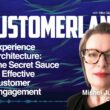Consumers provide vast amounts of data that could be used by brands to unlock exceptional, personalised experiences. Unfortunately in today’s fragmented omnichannel landscape, most of this data is ‘dirty’ — out-of-date, incomplete, incorrect or duplicated. This means many companies are missing out on amazing opportunities before they’re even aware of them.
But the act of constantly trying to ‘clean’ data takes the focus off the things that truly matter – teamwork, productivity, employee satisfaction, customer service and the bottom line to name a few. In fact, according to a recent study from Validity, 44 per cent of respondents estimated their company loses more than 10 per cent of their annual revenue due to poor quality CRM data.
The companies surveyed reported they lose customers, blow new business deals and delay revenue-driving initiatives like marketing and brand awareness campaigns – all because of subpar data.
By Billy Loizou
The truth is, customer data will always be messy
The idea that it can be ‘cleaned up’ is a costly distraction. While the organisation is busy trying to tidy the data, processes remain inefficient, employees continue having a heavier lift and customer experience remains clunky.
So, instead of trying to ‘clean’ the data, organisations need the right technology. They need technology that takes a flexible approach to gathering and matching data and can account for its ever-changing nature – allowing organisations to (finally) put their data to work.
When brands and organisations stop fighting against ‘messy data’ and start working with it, great things begin to happen for the business, employees and customers. Take a look:
For the business: Improve ROI from both technology and marketing
- Reduced programmatic onboarding fees
- Improved advertising match rates and cost per customer acquisition
- Eliminate duplicate household direct mail
- Confidently target new, high-value audiences
- Not paying to acquire customers you already have
For employees: Allows you to work smarter, not harder
- Improved marketer productivity with direct data access
- Cheering for point & click segmentation
- Eliminating the analytics query queue
- Liberating analysts to focus on highest impact work
- Boosted confidence with transparent, record-level access
For customers: Feel known, supported and rewarded
- Relevant and more effective customer journeys
- Driving repeated purchases & growing average order value
- Boosted conversions with personalised suggestions
- Growing loyalty membership with personalised messages
- Measuring what’s working across precise sub-audiences
Identity resolution for the win
Identity (ID) resolution is the process of connecting and matching different data points across multiple devices and channels to form a unified view of a single customer. It allows brands to connect the dots between their ‘messy data’ to form a complete picture of an actual person. ID resolution holds the key to treating your customers like the unique individuals they are, setting the stage for happy, repeat customers and no wasted money on duplicate marketing.
That’s why getting ID resolution right is the cornerstone of any brand’s success. When all departments across the company have the same access to customer information in real-time, customers are guaranteed a seamless journey at every touchpoint – whether that’s online, in-store or with customer service.
Winning the race to customer centricity
With the goal of inspiring everyone to run longer, faster and farther; Brooks always talked about putting the runner first, but it came up short on the insights needed to take action. Without a single view of the customer, the brand struggled to identify their needs and personalise effectively.
Data was stuck in silos and lacked both the accuracy and speed required for the team to move fast. The brand needed a unified view of the runner, so it could put its customer-centric mindset into practice and provide the right products and offerings.
By positioning Amperity, the only CDP that takes a comprehensive approach to helping brands use data to serve their customers at the centre of their tech stack, the Brooks team created a Customer 360 that could be used across the enterprise.
It unlocked Brook’s ability to put its runner-centric mindset into action. By applying insights to its digital marketing efforts, Brooks was able to create different audience segments, run tests within its marketing communications and use personalisation to put its best foot forward, ensuring runners’ needs were met.
With ‘clean data’, every team from digital marketing to customer service and operations had the insights and tools needed to position the runner at the centre of the strategy – fuelling personalisation and accelerating business growth.
“Amperity is crucial to our tech stack. In order for us to have a 360 view of the runner and then use runner data for analytics and marketing segmentation, a CDP is necessary. Our tech stack is always changing and very dynamic, so the ease of plugging in partners is also critical,” says Melanie Allen, Chief Marketing Officer at Brooks Running.
“(When it comes to metrics) we sit around the table and sometimes question, are these even real? Our click-through rate on paid search has gone up 260 per cent since starting with Amperity.”
3 Data strategies to unlock the value of customer data
1. Power the entire organisation with a customer 360 view: Customer data isn’t just for marketers. After building a unified customer database, that data is then available to advertisers, marketers, analysts, IT operations teams and product developers. This is precisely what it means to be customer-centric — using your customer data to inform all aspects of the business, not a single channel or department.
When everyone shares the same understanding of customers, the business is equipped to provide the best experiences and the most impactful strategies for long-term growth.
2. Build a best-of-breed martech stack: Brands often think they’re gaining efficiencies by using a single technology provider as their end-to-end solution for collecting, unifying and actioning on customer data. But the hefty price tags, archaic business models, slow-moving teams and behind-the-curve tech negate any perceived benefits associated with using a single vendor.
Instead, winning teams build best-of-breed stacks. This gives them the flexibility to customise their ecosystem based on their unique needs, and it also allows them to cherry-pick the leaders in each category, even as they change over time.
3. Take a leap with new technologies: More often than not, winning brands are trailblazers, offering new experiences, products or ways of engaging with their customers. This will inevitably involve some level of calculated risk. Playing it safe when it comes to technology is actually just the opposite. A wait-and-see approach means losing competitive advantage and lets early adopters reap outsized rewards and create insurmountable leads.
Brands mitigate risks by hiring a forward-thinking head of IT or an experienced Chief Innovation Officer whose job is to understand and vet the latest innovations. They also avoid the trap of the DIY approach, opting for outside teams of experts when the problems are new and difficult.
Find out more by downloading your copy of Amperity’s 2022 Guide to Using Customer Data Across the Enterprise here.
About the Author
Billy Loizou has over ten years’ experience in design, technology and marketing. He has worked with some of the world’s most renowned and respected brands, helping them improve their customer experience and drive profitability.
This article originally appeared in B&T.














1 comment